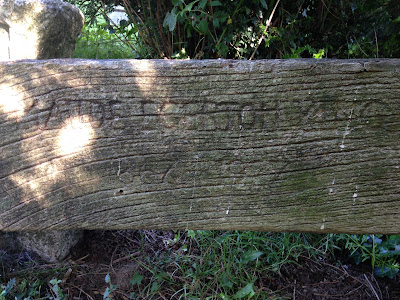Rev. R. L. Gales contributed plentiful pieces to
The Vineyard, in April 1911 he wrote an article called "The Queen of Festivals".
I do not know much about him, but a small bit of internet researching delivers some details on Richard Lawson Gales (1862-1927). Born in Littlehampton, he read English as Oxford University and won the Newdigate prize in 1886; a prize for the best composition of English verse by an undergraduate. He was ordained in 1888 and became the curate of Stanwick (1888-1895), then Kirby in Cleveland (1895-1896), Wanborough (1896-1907) and finally Gedney, Lincolnshire. I wonder if he met the Haslemere Peasant Arts movement whilst in Wanborough? This is approximately 15 miles away from Haslemere. Archive.org has a number of mostly poetry books by R. L. Gales
here, it includes titles such as
A Posy of Folk Songs,
Ballads & Carols and
The Vanished Country Folk.
In
A Posy of Folk Songs (October 1912) for example:
"Good Friday (A South German Volkslied, 1590)
As our Lord into the Garden went
The olive trees before Him bent,
The green leaves shivered, for they knew well
To-morrow’s Sorrow, ere it befell.
The fales Jews into the Garden came,
Judas the traitor had showed them the same,
Our Lord they took, His Head they crowned,
His Body they scourged, His Hands they bound..."
In "The Queen of Festivals" (The Vineyard, ibid) Gales wrote "A country without festivals must perforce be bleak and unhomelike - at least, no home for the spirit. I must confess that to me a festival is the greatest and most sacred of all great and sacred things...Allover Christendom the "Queen of Feasts", the Day of days, is not Christmas but Easter...
"It is fitting surely that the Resurrection should have taken place in a garden, and there can be no fitter way of celebrating it than our English custom of decking the churches with flowers. An English country church, to its dress of moss and primroses gathered by village children, has more of the spirit of Easter, at least to my own thought, than an Eastern shrine glittering with candles, or an Italian basilica strewn with laurel. But the flowers should be fresh spring flowers, and wild, shy, wood things. Talking of plants and flowers, it used to be an old country custom for people to eat a taury pudding on Easter Day. The meaning of the name is, of course, a deathless plant, the life-giving herb. An old English name for the wood-sorrel was "alleluia". It is a lovely thought to think of the earth being thus carpeted with Easter praise.
"In this garden, the Easter sunrise took place at midnight, long before the rising of the earthly sun. The old devout writers always speak of it as the Coming of the True Brightness, the Light springing up for the righteous, shining on those in darkness and the shadow of death. The evil spirits were scared by its Rising like owls, and bats by the sun.
Barbagianni, the great owl
In his ancient ivied keep,
Hunting, in the midnight deep,
Helpless mice and poor small fowl,
Flutters in a blind affright
At the sudden silent light.
"Hilarity, gaiety, has always been the note of the popular keeping of Easter. The mediaeval name for its joyous pranks and games were "Paschales risus" "Easter laughter". There were in the Middle Ages cathedrals where the canons played at ball in the nave on Easter Day...Another North Country custom is that of rolling coloured Easter eggs by the children, this too on Easter Monday. The egg, of course, has always been a type of the new life of the Resurrection. The song of that new Life is "Alleluia". The very name is synonymous with Easter. It is the song of recompense and renewal, beauty for ashes and the oil of joy for mourning. It was, and I hope still is, a piece of popular custom that one must always put on something new for the first time on Easter Sunday, must wear upon that day some token of the new creation, the everlasting renewal. For Easter means "the restoring of the things that have been cast down, the renewing of the things that have grown old, the return of all things to their perfection through Him in Whom they had their beginning, Jesus Christ Our Lord.""



















































